Great Britain defeated the Germans in the Battle of Britain only thanks to Polish pilots flying in English and Polish fighter squadrons. Had it not been for the Poles, the air defense of Great Britain would have been broken, and this would have meant the landing of Wehrmacht troops on English beaches. The RAF had a huge fleet of fighter planes, and factories around London were working at full speed and building more, but there were not enough English pilots. Poles gave England a chance to survive.
Such an analysis of the Battle of Britain was presented by Colonel pilot Marian Duryasz, who - first in the English 213 squadron, and then in the Polish 302 squadron, fought in 1940 and the following years until the end of the war. In the book "My soaring fights. Memoirs of the 302 Squadron commander ” , which has just been released, described his fate from his early youth and starting his studies at the Aviation Cadet School until the post-war times.
145 Polish pilots fought in the Battle of Britain, but only a few of them wrote down their memories. "My sky-battles" by Duryasz are valuable, among others because the author writes without blaming the bush about the mistakes of Polish and English commanders, private and official conflicts, political puzzles, disputes, games and wars. You can see that such situations irritated him a lot, because for him the most important thing was to fight the Germans until they were defeated.
From Serock to Grudziadz
Marian Duryasz was born on December 14, 1911 in the village of Karolino near Serock. These lands were then under Russian occupation, and the prospects for Poland regaining independence were not optimistic. Fortunately, in 1918 the Commonwealth returned to the maps, and little Marian could go to a Polish school and learn in Polish.
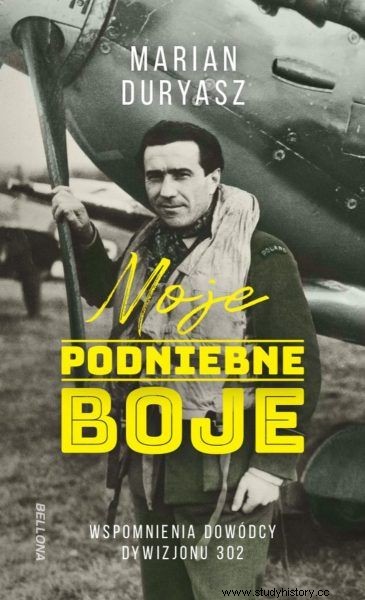
Already as a young boy, he decided to pursue a military career. In the interwar period, the uniform was held in high esteem in Poland, the army guaranteed good and stable working conditions and pay, so it should not be surprising that Marian preferred uniformed service to farm work done by his parents. The military certainly gave him greater prospects and the opportunity to learn about the world. Indeed, he has visited a large part of this world. But he was driven into the world by war, not just curiosity.
Duryasz joined the Cadet Corps as a teenager, underwent military training, obtained the rank of corporal and, in 1932, passed his secondary school-leaving examination. Then he decided to become a fighter pilot. It was not just any decision, because only candidates with very good academic results (especially in mathematics and physics) and in excellent health were admitted to the Aviation Cadet School. However, even the healthiest and best on earth dropped out later during training in the air, when it turned out that they had a poor "feeling for the plane". Marian Duryasz overcame all obstacles quite smoothly and realized his dream - first he became an aviation observer, and then a fighter pilot.
Looking for an answer to the question of where the later successes of Polish pilots in the Battle of Britain came from, we find it in the biography of Duryasz. His training was indeed in-depth, a long time, hundreds of hours on the ground and many hours in the air. From entering the Dęblin school in 1932, more than four years passed before he received his first assignment as a fighter pilot. In the fall of 1938, he became an instructor of higher pilotage to train subsequent years of fighters.
The training was multidisciplinary. Pilots flew many types of aircraft, from obsolete biplanes to relatively modern high-wing aircraft. Duryasz started flying the reconnaissance planes withdrawn from the units - Potez XV or XXVII biplanes, then he underwent training on gliders, and then switched to a training plane of Polish production RWD-8. Then there was the French Morane Saulnier AR-35, a machine from the First World War. After mastering the piloting and acrobatics, the pilots switched to Bartel planes. It was a Polish-made biplane with a retracted lower wing, equipped with an engine power of about 120 HP.
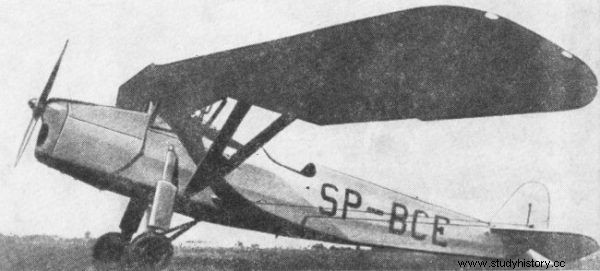
RWD-8 - Polish training plane. The Polish pilot trained on such a model
This plane was not very popular among students. Each start was a serious experience, because in the event of an engine interruption - which happened relatively often - it was rare to come out alive or with a slight injury. Such accidents usually resulted in tragic or serious injuries
- recalls Duriah.
After the flights on Bartel, the program of which was shortened due to the widespread fear of flying on this plane, aviation adepts switched to PZL Ł.2, also a machine with a weak engine, often failing, which contributed to many accidents, including fatal ones . According to Duryasz, this plane was sent for training precisely because it was a failed construction and very difficult to pilot. Finally, the pilots got on to the relatively good and relatively modern Polish PWS-26 used for advanced training. On two-seater planes with an instructor, the pilots made about 70-80 flights, and only after that they were allowed to fly in single-seat planes. At the same time, many pilots were not admitted to this stage because the teachers noticed shortages in training or features that disqualified candidates for fighters.
At the beginning of 1935, Duryasz completed all stages of the training and reported to the 6th Air Regiment stationed in Lviv, where he was assigned to the 65th Airline Squadron equipped with outdated but liked by Bregueta XIX pilots. Duryasz recalls that in the following years he was constantly training, and commanders and instructors required more and more. There were also air accidents in which both instructors and young pilots died.
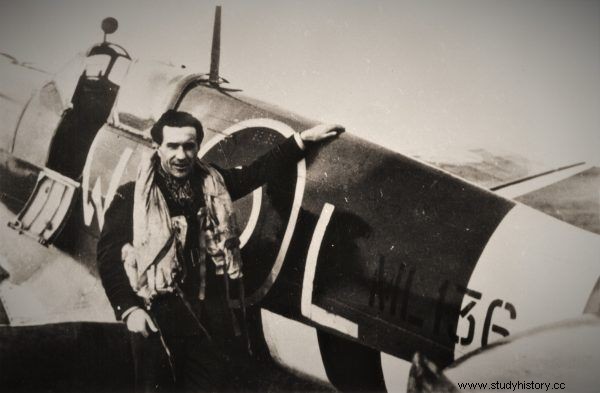
Marian Duryasz - Polish pilot in England
Flights started very early in the morning. We got up at 4 and we went to the airport, from which we descended around eight o'clock. After rest until 5 p.m. or 6 p.m., depending on the weather, we again went on flights that lasted until dusk
- recalls the author of "Sky battles" .
In later years, Duryasz also flew on the licensed Czech PWS-10 and Czech Avia BH-33, which he praised very much for its ease of piloting and excess power compared to previous aircraft, which lacked power. Finally switched to the PZL-7, the first aircraft that was still used in combat units. In 1936 he was transferred to the excellent 3rd Aviation Regiment in Poznań, where he mastered the PZL-11c pilotage, the famous "Eleven", and from 1938 he was an instructor at the Higher Pilotage School in Grudziądz. The city was located only 8 km from the German border, so in May 1939, in the face of the impending war, the school was moved to the airport in Ułęż near Dęblin, where at an accelerated pace intensive training of pilots, who flew up to eight hours a day, was carried out.
Tragic September, pilots ground
Duryasz remembers the September campaign of 1939 with great bitterness as a period of missed opportunities.
The Sunday morning of September 1, 1939 was beautiful. The morning radio news reported that the Germans had invaded Poland and fierce border fighting was ongoing. Nothing unusual was happening on the school grounds. In the morning we were gathered at the airport in front of the hangar and the school commander announced that we were at war with Germany. According to the previous guidelines, we were to defend the Dęblin junction of airports and bridges on the Vistula and Wieprz rivers against air attacks.
As the German machines did not reach Dęblin, it was thought that the Polish air force stopped them. It was just the opposite. At that time, it was the Germans who massively dropped Polish planes to the ground and quickly gained air superiority. When the German He 111 was finally spotted at the airport in Ułęż, Duryasz chased him on his PZL-7. The bomber did not catch up, however, because the "seven" was an outdated and too slow machine. Duryasz also mentions that the bomber squadron with the Łoś planes forwarded to Ułża did not show any activity for the next few days, despite the enormous indignation on the part of both the Łoś pilots and the fighters.
From September 3, Duryas' unit did not fly because they were forbidden. The planes were to be deployed remotely and masked, and the pilots were only to be on duty with them.
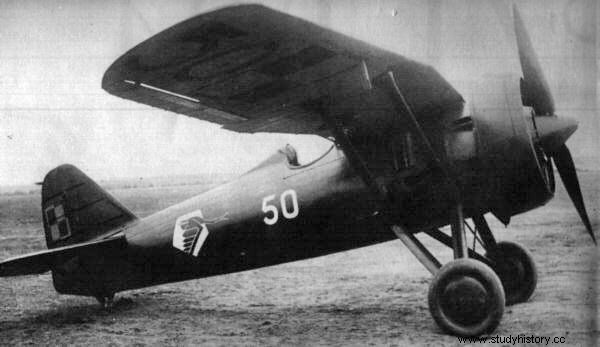
PZL P.7a - Polish fighter plane
I was, together with Sec. Żurakowski, on duty at the airport in Podlodowo, when two or three He 111 planes abused a train on the Łuków-Dęblin railway line, which ran a few kilometers north of the airport. He 111 dropped bombs one by one, fired machine guns at the train for several minutes, and we stood and watched helplessly because it was not allowed to take off
- Duryas writes bitterly.
He also points out that the Germans have always known where the valuable bombing facilities are, where the planes and air personnel are stationed. German intelligence and the 5th column worked well. In turn, the Polish Army was constantly retreating and on September 7, the aviation school received an order to evacuate from Dęblin to the Sokal area near Lviv. Cadets and non-commissioned officers were to get there by train, and the planes - by air throw. After landing at this secluded airport, the ban on combat flights was upheld. The rest of the school staff was due to arrive the next day, but never did. There were no trains, so the pilots and the ground crew had to march to the South-East, where after September 17 they were captured by the Soviets and most of them died in Katyn and Kharkiv.
In the second week of September, Duriah had the opportunity to observe the bombing of a small railway station crowded with evacuation trains, which were bombed by three He111s. Trained pilots who had several operational planes watched the tragedy from the nearby hill. They could not take off, however, because they were grounded by some stupid order from the very top.
Around September 13, the aviation school was ordered to move towards the Romanian border and cross it. It happened on September 15 in the area of Sniatyn on the Prut. Here Duryasz and his colleagues met other Polish pilots from fighter squadrons, who were also sent to Romania, and they did not fight the Germans, because there were no machines for them. The "Polish campaign of 1939" ended for Duryasz already in mid-September.
Via France to England
According to the orders, the soldiers evacuated to Romania and Hungary were to get to France as soon as possible, where the Polish Armed Forces were to be rebuilt. After many adventures, after a trip through Yugoslavia and Italy, Marian Duryasz with his fellow pilots also arrived there. They were hoping to fight the Germans as soon as possible and to pay them back for the September defeat. However, Polish pilots, perfectly trained, many with combat experience, encountered a wall of reluctance and disbelief in their abilities. Only a few were assigned to combat units and received machines. France, in June 1940, succumbed to Germany as quickly as Poland. Then Great Britain became the last stronghold of defense against German expansion. Duryasz did not have the opportunity to see the defeat of France, because he had been ordered to go to England earlier. He left Lyon on January 25, 1940.

German soldiers at the Arc de Triomphe Paris, June 1940
In the following months and years, it was constantly transferred from squadron to squadron, and then from one training center to another. After arriving in England, he was assigned to the English squadron 213, on October 20 he was transferred to the Polish squadron 302 "Poznański", on January 31, 1942 to the 317 squadron "Wileński", from June 1, 1943 he flew in the 316 squadron. He also had a short episode in the famous 303 Squadron. From 8 July 1944 he was the commander of the 302 Squadron.
He flew Hurricanes, Spitfires and Mustangs. He recalled that the first phase of the Battle of Britain was difficult for him not only because of the unfamiliarity with the machines, air tactics of the RAF and the terrain over which he had to fight. English was also a problem, which Durias did not know at that time.
I heard a lot of conversations on the radio - both from the ground and my commander's replies - but basically, except for single words, I did not understand anything. It is true that the English drew me to their company, tried to speak to me, but what a conversation, mostly in sign language, was it? However, this period helped me immensely in learning the language. After a month I was able to communicate with them somehow
- he recalled.
The technique was also a real problem. The planes that Poles received in England were not only almost twice as powerful and faster than the Polish ones, but also equipped with previously unknown technical solutions, such as retractable landing gear, flaps, on-board instruments calibrated according to a different system of measures and weights, etc. It was a nightmare in the beginning that on English planes the throttle was working in the opposite direction. So, when a pilot trained in Poland wanted to increase the engine speed, it dropped. And vice versa. It was very dangerous.
All these obstacles were overcome, however, and Marian Duryasz mastered the English language so well that later it was considered a more valuable skill than combat flying, and more and more often he was grounded and entrusted with coordinating or command functions. Nevertheless, he managed to shoot down three German planes for sure and one probably, which is not a bad result. The pilot from Serock recorded the Me-110 - shot down on September 11, 1940, Do-17 - shot down on September 15, and Fw-190 - shot down on April 28, 1942.
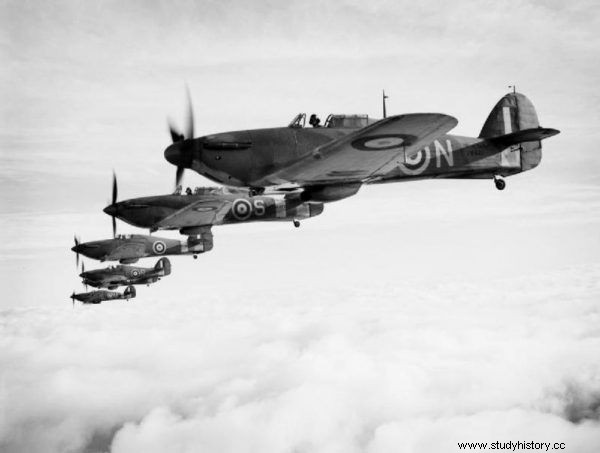
The Polish pilot flew, among others on Hurricane airplanes. Pictured:Sea Hurricanes Mk IB in formation, December 1941
Duryas reported a He-111 hit on September 26, 1940 as a probable shoot-down that flew over the English Channel towards the coast of France with a smoking engine. During the Battle of Britain, he happened to take part in battles with over 100 German planes, half of which were always fighters. This time, however, in contrast to the Polish "sevens" and "eleven", the machines on which the Poles flew were as technical as possible to airplanes with crosses on the wings.
While dodging, I noticed that I was being attacked by four or five Me 109s that I had never seen before. They most likely came at the time of our attack or were much higher. So I found myself in dire straits because they were attacking one after the other. Many thoughts skip at such moments, but one, as it turned out, was salutary. I was reminded of what the instructor said that the Me 109 is worse right-hand than the Hurricane. So I quickly made a tight right turn and tried to get away from the enemy planes as soon as possible
- we read in "Sky battles" .
In several places, Duriah shares his views on the potential chances of winning the Battle of Britain. He believes the chances were level.
(...) (English) squadrons did not have any spare pilots at all, so that some of them were on duty from morning to night. The upcoming additions to the pilots were sufficient to the necessary minimum. The situation with airplanes was better. Almost always a squadron had two or three in direct reserve. As soon as the losses were incurred, the squadron was replenished with planes in a few hours. It was worse with the pilots.
- he recalled.
At the height of the Battle of Britain, the pilots flew daily and took off multiple times. Many experienced nervous disorders and could not eat. They were disappointed and endured the days when the Germans did not come to the Islands.
The flight itself, even without meeting the enemy, was a tremendous relief. On the other hand, sitting and waiting for something - in this case when it is something high at stake - is tiring and exhausting mentally
- Duryasz writes in his memoirs.
The constant "fluidity" of the flying personnel also exacerbated the stress. Young pilots usually died in the first 10-15 combat flights. If this period managed to survive, the pilot became an experienced fighter and a tough opponent.

Thanks to the persistence of the Allied pilots, the Battle of Britain was settled in favor of the Allies. But both sides were completely exhausted. The Germans lost 1,733 planes, the English lost 1,087. 544 Allied pilots were killed and 500 were injured. The Germans lost about 2,500 airmen (killed and captured) and about 1,000 wounded. 145 Polish pilots fought over London, 28 of whom died (and the famous Czech - Jozef Frantisek from 303).
Polish pilots are credited with shooting down about 170 and damaging 36 planes. Squadron 303 was the best of the squadrons in the Battle of Britain, assigned the destruction of 126 German planes.
In the final phase of the war, Marian Duryasz took part in the cover of the Allied landing in Normandy (D-Day), and then in the battles over the continent. On January 1, 1945, he moved to the staff of the British 2nd Air Army to the position of operational officer, while serving as the deputy commander of Polish Aviation on the European continent. At the beginning of April, the staff was transferred from Brussels to Germany near München-Gladbach, where it remained until the end of the war.
In Alhorn, Germany, he was found by his wife and son, Wojtek, with whom they moved to England for a while. Duryasz wanted to return to the country, although he was afraid that he would be persecuted by the security services for his service in the Polish Armed Forces in the West. Ultimately, however, he decided to return and on July 30, 1947, the Duryasz family arrived in Gdańsk with "Batory". The English themselves, who forgot about the Battle of Britain already in 1946 and saw the "Poland" badge on the uniform instead of "my hero", called "go home" of considerable "merit".
Air control over southern England was a necessary condition for the Germans to attempt an invasion. They did not manage to achieve this air domination, so Hitler gave up the conquest of Great Britain, which then carried the burden of fighting against the Third Reich on its shoulders. It was then that the Germans suffered the first defeat of strategic importance in this war. Not bloody battles fought on the ground, but the air struggles over England in the summer of 1940 are the only breakthrough battle of World War II, in which the participation of Poles had a significant impact on its victorious ending
- wrote the author of the preface to "My sky battles" Wojtek Matusiak, aviation historian.
Source:
The article is based on the book Moje podniebne buoje. Memoirs of the commander of the 302 Squadron Marian Duryasz , published by Bellona Publishing House in connection with the 80th anniversary of the Battle of Britain
